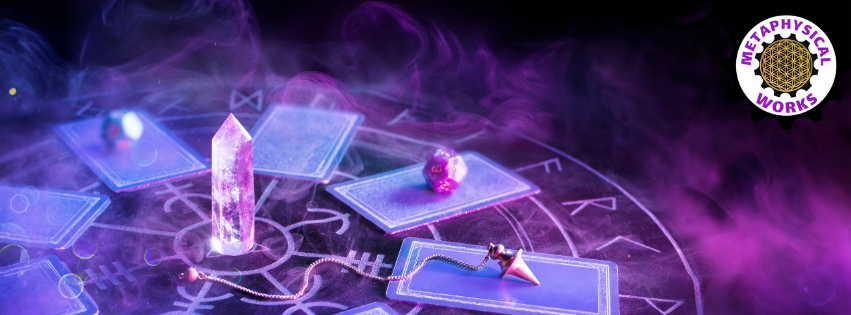Samhain: Rituals, Reflections, and Offerings for the Season of Spirits
By Jesse Hudgins
Oct 21, 2025
Add a comment
Stepping Into the Shadows
As October wanes, the world softens and slows. The trees, once full and vibrant, now stand like quiet sentinels, their branches releasing the last of their golden leaves. The air carries the scent of woodsmoke and damp earth, a whispered reminder that the year is drawing to a close. There is a stillness now - a hush that invites us inward, into reflection, into remembrance.
This is Samhain (pronounced SOW-in), one of the most sacred sabbats in the Wheel of the Year, celebrated from October 31st through November 1st. It is far more than a seasonal marker; it is a threshold, a liminal space where the old year dissolves, and the new one waits in the dark, ready to be born. Samhain calls us to pause, to honor the turning of the seasons, and to recognize the cyclical nature of life and death that we are all a part of.
During this time, the veil between the physical and spiritual worlds grows thin, making it easier to connect with the unseen - our ancestors, our guides, and the quiet wisdom of our own souls. This is a season of reverence and mystery, a time when we are invited to step fully into the shadows, not with fear, but with courage, curiosity, and an open heart.
Samhain is not just a date on the calendar; it is a feeling, an energy, a sacred reminder that endings are never truly endings - they are transitions, gateways to something new. Whether you are a seasoned practitioner or someone just beginning to explore the rhythms of the Wheel of the Year, Samhain offers a profound invitation to slow down, honor your roots, and reclaim the quiet, transformative magic of this powerful season.
Other Names for Samhain
Samhain is a deeply Celtic celebration, but the festival - and the concepts of honoring the dead and marking the shift into the dark half of the year - has been known by many names across different cultures and eras:
- Feast of the Dead - An ancient reference in Celtic lands, highlighting the importance of ancestral reverence.
- Witches’ New Year - A modern neopagan term reflecting Samhain’s role as a spiritual reset.
- Shadowfest - A name often used within certain Wiccan and neo-pagan traditions.
- Nos Calan Gaeaf - In Wales, this marks the night before the first day of winter.
- Celtic New Year - A nod to Samhain’s role as the end and beginning of the spiritual cycle.
- Halloween - The modern evolution of “All Hallows’ Eve,” influenced by Christian and folk traditions blending over time.
Across cultures, while the names may change, the themes remain the same: death as transformation, reverence for the unseen, and connection with ancestors.
The Spiritual Meaning of Samhain
The word “Samhain” translates to “summer’s end”, signaling the close of the light half of the year and the descent into the dark. For the ancient Celts, this was more than a seasonal shift - it was the new year, a time for endings, reflection, and preparation for the quiet introspection of winter.
Samhain is rich with symbolism that speaks to the deeper truths of life and spirit:
- Death and Rebirth: Recognizing endings as sacred transitions that make space for new beginnings.
- Ancestral Veneration: Honoring those who walked before us, weaving their wisdom into our own journeys.
- Shadow Work: Embracing the parts of ourselves we often avoid, seeking healing and integration.
- Divination: Using this heightened spiritual season to gain clarity, insight, and guidance from the unseen.
Rather than fearing the darkness, Samhain encourages us to explore it - to see it not as absence but as potential, a fertile space where transformation takes root.
The Origins and History of Samhain
Celtic Roots
Samhain’s origins stretch back thousands of years to the ancient Celtic tribes of Ireland, Scotland, and Wales. As an agrarian society, the Celts followed the cycles of the earth. Samhain marked the final harvest, when fields were cleared, livestock were brought closer to the hearth, and preparations were made for the lean, dark months ahead.
It was during this liminal season that the Otherworld - the realm of ancestors, spirits, and the fae - was believed to draw close. Fires were lit on hilltops to guide wandering souls and to ward off mischievous or malevolent energies. Offerings of food and drink were left at thresholds or sacred spaces to honor and appease the unseen.
From Samhain to Halloween
The story of Samhain’s transformation into Halloween is a fascinating weave of history, spirituality, and cultural evolution.
For the ancient Celts, Samhain was a sacred fire festival - the spiritual and agricultural new year, a time when the harvest was complete and preparations began for the dark, cold months ahead. The thinning veil between the physical and spiritual realms made this season sacred for honoring ancestors, seeking guidance, and protecting the living from harmful energies.
As Christianity spread through Celtic lands in the early Middle Ages, the Church sought to integrate and reframe local pagan practices. By the 9th century, All Saints’ Day (also called All Hallows’ Day) was established on November 1st, with All Hallows’ Eve - the night before - falling directly on the traditional celebration of Samhain. This was not a coincidence but a deliberate attempt to align and eventually replace the old pagan observances with Christian rituals.
Over time, folk practices and sacred traditions intertwined:
- Bonfires, once lit to guide and protect souls, continued to burn - but now in honor of saints or to ward off wandering spirits.
- The custom of leaving offerings of food and drink for ancestors evolved into “soul cakes” given to the poor or to children in exchange for prayers for departed souls, an early version of today’s trick-or-treating.
- Carved turnips, and later pumpkins in North America, became lanterns to light the way for spirits - or to ward off trickster entities.
By the time European immigrants carried these traditions to North America, the celebration had shifted further, blending with regional harvest festivals and folk customs. The result is what we now recognize as Halloween - a night of costumes, jack-o’-lanterns, and playful nods to the supernatural.
Yet, beneath the modern commercial layers, the ancient pulse of Samhain still beats. The instinct to honor the dead, to gather in community as the year darkens, and to face the mysteries of life and death with reverence and curiosity remains. When we light a candle in a window, carve a pumpkin, or pause in remembrance of those we’ve lost, we are participating - knowingly or not - in a lineage of ritual and reverence thousands of years old.
Today, modern witches, pagans, and spiritual seekers reclaim this season as both Halloween and Samhain, blending lighthearted fun with deep, intentional spiritual practice. It is a reminder that while names and symbols may change, the heart of the tradition - honoring the unseen and stepping into the mystery - endures.
How to Celebrate Samhain
Whether you’re a seasoned practitioner or just beginning your spiritual journey, Samhain offers countless ways to connect, honor, and transform. Here are some deeply meaningful rituals and practices to explore:
1. Create an Ancestor Altar
- Choose a quiet, respectful space - a table, shelf, or windowsill.
- Place photos, heirlooms, or items that remind you of your loved ones.
- Add candles, seasonal fruits, and offerings such as bread, wine, or incense.
- Sit in quiet reflection, speaking their names aloud, sharing memories, or simply sitting in their presence.
2. Hold a Dumb Supper
- Prepare a meal - simple or elaborate - with intention and love.
- Set an extra place at the table for your ancestors.
- Eat in silence, opening your senses to their presence and any messages or feelings that arise.
- Leave a portion of the meal as an offering of gratitude.
3. Work with Divination Tools
- Pull cards with a tarot or oracle deck for insight.
- Use runes or pendulums for clarity on specific questions.
- Try scrying with a black mirror, bowl of water, or candle flame for visions or symbols.
4. Light a Bonfire or Candle Ceremony
- Write down habits, fears, or patterns you wish to release.
- Burn the paper safely in a fireproof dish or outdoor fire.
- As the smoke rises, visualize those energies leaving your space and making room for renewal.
Crystals and Herbs for Samhain
- Crystals: Obsidian for protection, Labradorite for psychic insight, Amethyst for spirit communication.
- Herbs: Mugwort for dreamwork, Rosemary for remembrance, Wormwood for spirit contact.
Honoring the Turn of the Wheel
Samhain is not just about endings; it is about the sacred cycle of transformation. Just as the natural world sheds what no longer serves - the leaves falling, the earth resting - we, too, are called to release and prepare for renewal.
Take time during this season to reflect on the past year: What have you learned? What is ready to be released? What intentions do you want to carry forward into the new year?
Final Thoughts: The Wisdom of the Veil
Samhain teaches us that death is not an end but a passage, a sacred transformation that is as natural as the falling of leaves or the setting of the sun. As the veil thins, we are reminded that the worlds of the living and the unseen are never truly separate - they simply exist in different layers of the same sacred tapestry.
This season asks us to listen deeply: to the whispers of our ancestors, to the quiet voice of our intuition, to the lessons carried by the cycles of nature. Whether you celebrate with elaborate rituals, simple offerings, or moments of silent reflection, your practice is enough. The magic of Samhain lies not in complexity, but in presence - in your willingness to step into the moment with reverence and intention.
As the Wheel of the Year turns, take time to honor what has ended in your life and to set intentions for what you wish to call forward in the months ahead. Light candles for those you love, speak their names, and feel their presence woven around you like a warm cloak. Let the stillness of the season ground you, guide you, and remind you that you are never truly alone.
This is the wisdom of the veil: that life and death, shadow and light, endings and beginnings are all threads of the same eternal weave. As you move through Samhain and into the quiet of winter, may you find peace in the mystery, strength in your roots, and courage in your becoming.
Blessed Samhain, dear soul. May your path be lit with love, your heart held in ancestral embrace, and your spirit renewed in the quiet alchemy of this sacred season.
Thank you for reading and sharing this space with us.
Stay connected with Metaphysical Works - subscribe to our newsletter for rituals, guidance, and seasonal wisdom delivered straight to your inbox.
Follow us on Facebook and Instagram for inspiration and updates on our latest offerings.

